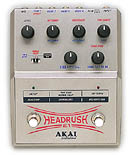|
|
|
 |
|
Review of Akai Headrush E1
By Alan Imberg 4/20/99
|
|
|
|
|
|
|
| After playing with my new Headrush pedal for a couple of days, I can say with confidence that it was worth the investment of $207 (including tax and shipping). Akai seems to be marketing the Headrush accurately as a powerful stomp box, nothing more and nothing less. The Headrush has 3 modes: Tape Echo, Normal Echo, and Loop Recording. I'll comment on each mode individually.
Loop Recording:
- The Headrush can record a single loop up to 23.8 seconds long or an overdubbed loop up to 11.9 seconds. The interface is nice and simple for creating the length of the loop on the fly. There are two foot switches. The left switch activates the function and the right switch is used to determine the length of the loop. If you want to overdub a loop, click the left switch to activate the looping function and start playing. Then click the right button once to start recording. Clicking the right button a second time will close the loop. Click the right button a third time will allow you to record infinite layers on the original loop. To play over the overdubbed loop without recording, click the left button. To erase overdub loops, click the right button again to erase all but the original loop. If the original loop goes over 11.9 seconds, then you are committed to only one loop; you will not be able to overdub. An LED light above the right pedal will begin to flash a few seconds before you reach 11.9 seconds, notifying you to either close the loop or live with the consequences. The LED light will flash again a few seconds before reaching 23.8 seconds, letting you know that the loop will automatically repeat. One drawback is that you can't tell the exact length of the loop. I find it helpful to know exact lengths for syncing drum tracks and such. However, I can determine with ease the length of a loop by feel, which is nice.
Normal Echo:
- The maximum tap tempo delay time is 23.8. Again, the left switch activates the function and the right switch is used to determine delay time. Click once then click a second time. The time between clicks is your delay time. There are course and fine Time dials to manually manipulate delay time. The sound quality is pretty good. The sampling rate and resolution are the same for all three functions: sampling rate = 44.1 kHZ; resolution = 16 bit.
Tape Echo:
- This is the coolest function of the three. The Tape Echo function is designed to simulate a 4 head analog tape delay. Each head has its own output so that you can send multiple signals from the Headrush to multiple amps or mixer channels. I plugged all 4 into my 8 track recorder and was impressed. There is a Head-Gap dial where you can sync up the delay times of the heads or stagger them. When they are staggered and you use the individual head outputs, you get some cool quadraphonic echo. Maximum delay time in the Tape Echo mode is only 5.9 seconds which kind of sucks but I'm not complaining. Activation and setting of delay time is performed in the same manner as in the Normal Delay mode. There is a HF Damp function that allows you to dampen the frequency of the delay feedback. This is supposedly designed to replicate the lo-fi qualities of the old analog tape delays. It may be a useful tool but the sound quality is too good to be mistaken for old tape heads.
There is a three stage switch to change the modes. There is also a mono output for the non-Tape Delay modes and for consolidation of all the tape head signals. The pedal is quiet enough for me to run direct to my 8 track recorder. All in all, a cool tool.
|
|
|





